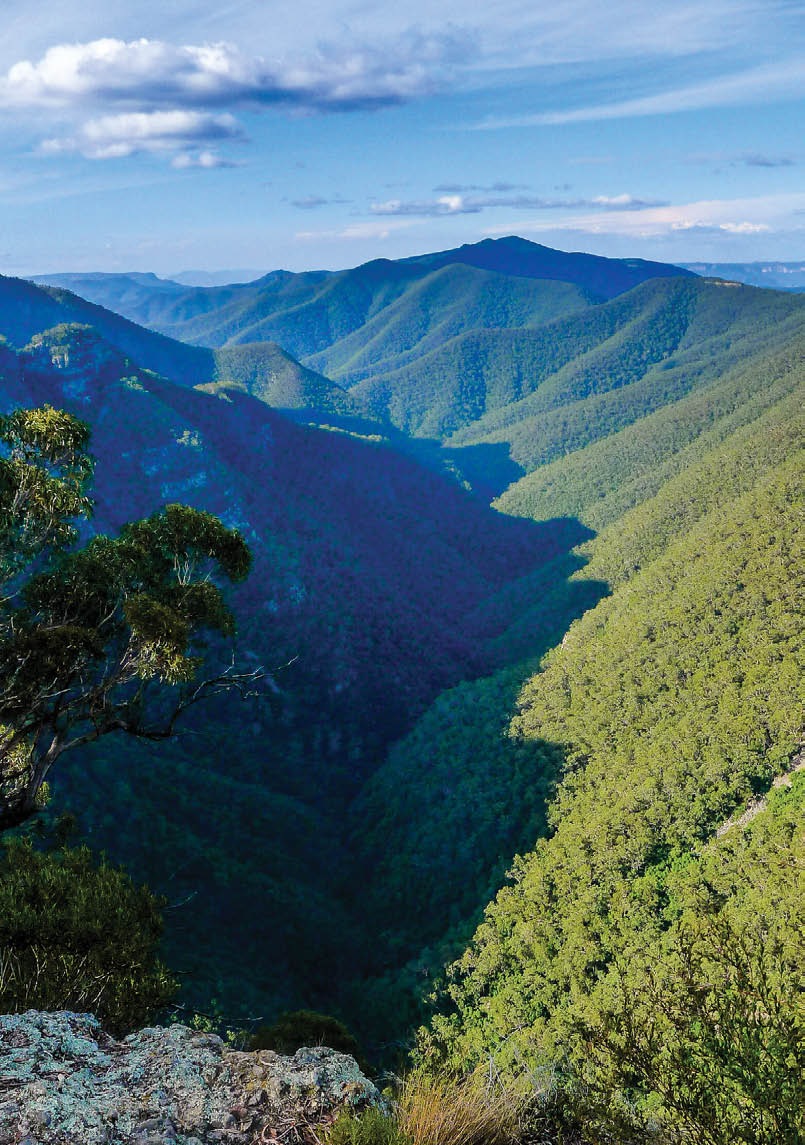


The knolls of Rip, Rack, Roar and Rumble saw-toothed away in the distance, a ragged bread knife serration from mounts Stormbreaker up to Cloudmaker. Looking north across the suicidally plummeting hillsides of Kanangra Gorge, the ragged cleft of Pooken Hole and the mysteries of the Pit of Seriphos were secreting treasures in their deep, tree-packed folds as they fell away from Mount Danae.
Deep down into Kanangra GorgeAll pictures by Craig N. Pearce

“Dreamtiming”
Going Gangerang to a 100 Man Cave
Craig N. Pearce

28 | BWA June 2019
The walk to 100 Man Cave – cloistered away in the depths of Kanangra-Boyd National Park (NP) – had barely begun, yet already the journey’s landscape, views and place names were co-mingling to provoke what the best bushwalking always does, an unleashing of the imagination as much as a revitalisation of body and soul.
This “unleashing” contributes to literature being such an inspiring and enlivening companion for the outdoors experience. It is a raging, fecund turmoil and it conjugates additional resonances, prompting the mind down lubricous corridors it might otherwise not have ventured, enriching our engagement with the wilderness – a joyous flexing of the heart.
Like Proust’s iconic madeleine sensation, walks in the wild bring memories flooding back, then connect them to our experiences – current, past and, perhaps, anticipation of the future. It is the walker’s choice (and conditioning) that determines what partitions of the mind are opened to this experience and where the connections are made. Is there a specific set of mental monkey bars being grappled with for any one walk? Or is it a tumble of random moments chaotically conflated into play?
The synaptic Lollapalooza fuelling internal illumination on the 100 Man Cave walk was my contemporaneous reading of Understory, A Life With Trees, by Inga Simpson, a memoir dedicated to nature in a multiplicity of places and ways.
In Understory, Simpson frequently reflects on other writers’ intellectual and physical outdoors investigations. An example is Wallace Stegner, who has delved into the notion of landscape being a screen through which you see – and hence interpret – the
world. The landscape, then, is impacting on what you are thinking, and how you are thinking, boost-juicing the connections, interpretations and – here we have the nub of it – creative digressions being nurtured in the greenhouse of your brain.
Deep dive into Kanangra-BoydSo anticipated by me before arrival – excited by photos, rumours, barely believable place names and random track notes – Kanangra’s signature burnished honeycomb-coloured walls possessed the envisioned solemn grandeur. The Kanangra Gorge – fathomless and profound at its inception, 400 metres of falls plunging through a series of eight waterfalls into the “Deep” – trails away into the vast Wild Dogs distance. For me, this was the exhilarating centrepiece of the experience – astonishingly untamed for something so close to seething Sydney.
The closest town for supplies is Oberon. From Sydney the quickest and most direct access to the 716 square kilometres of the Kanangra-Boyd NP is via an awkward dog leg through Mount Victoria and Jenolan Caves. It’s about four hours from central Sydney to the Walls and the boundary of the Kanangra-Boyd Wilderness Area. Wilderness areas are the most protected category of lands in the national parks system, and this one covers sections of both the Kanangra-Boyd and Blue Mountains National Parks.
The Kanangra-Boyd NP is comprised of extensive plateaus and deeply dissected valleys. The park has geological evidence of processes that occurred 400 million years ago in the Palaeozoic era. Much of the outcropping bedrock is from the Ordovician, Silurian and Devonian periods.
Following these times, Kanangra granites and Permian and Triassic sediments evolved.
The views are compelling, but the plummet is one-way only
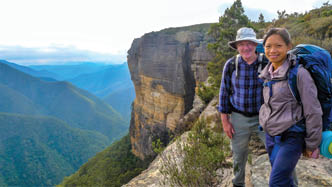
Mysteries abound at the head of Kanangra Gorge

BWA June 2019 | 29
These now form the higher areas of the park’s Boyd, Kanangra Walls and Ti Willa plateaus. In the latter part of these periods, tectonic events associated with the opening of the Tasman and Coral Seas resulted in the uplift of eastern Australia. These formed the trademark sandstone escarpments of both the Kanangra-Boyd and Blue Mountains NPs.
The Kanangra Walls are the western-most part of the Narrabeen Sandstone deposits, lying over ancient shales and quartzites. Below the cliffs lie Devonian period rocks, folded and hardened by high temperatures and pressure from movements in the earth’s crust.
The park’s current landform is the result of uplifting, followed by erosion. Sandstone has weathered into the region’s characteristic cliffs, while Devonian rocks have resisted erosion until, inexorably, they have been cut into yawning V-shaped valleys. In distant parts of the park there are granite canyons, the result of stream flows that have been occurring for millions of years, forming a landscape distinct from the surrounding Blue Mountains.
Aboriginal peoples’ long occupation of the area will come as little surprise, with rock art providing evidence of this on the journey, while the vicinity’s Thurat naming regime is believed to be of Aboriginal origin.
White man incursions into the area first occurred in 1802, but it probably wasn’t until 1833 before Kanangra Walls were first sighted by Europeans. The area was logged and used for stock routes over the years, though by 1937 a large tract of land was
reserved for the preservation of native flora and fauna, before the Kanangra-Boyd NP was declared in 1972. This is now UNESCO World Heritage-listed. The declaration of the national park followed a long campaign driven by conservationists such as The Colong Committee and Myles Dunphy, which stopped mining and forestry activity.
Clubbing in the cave The 13 kilometre one-way walk to 100 Man Cave is primarily undertaken along the Gangerang Range ridge. Vicious drops exist on its north-western side, where the Kanangra Gorge carves its way up to Coxs River, views dissipating into the haze. Out to the west, less visible through the forest, are more of this part of the world’s massive walls, glowing in the distance beyond the Gingra Range and Kowmung River. Short bush bashes provide numerous gnarly outcrop-levitated views of this expansive wilderness.
The walk begins from a trailhead at the end of Kanangra Walls Road, dropping easily down onto the Kanangra Plateau, an area predominantly covered by heath and, as with much of the walk, punctuated by a range of different banksia species, often low-lying among the similarly crouching heath. Their lantern-like heads feature a myriad of individual flowers, many of richly burnished hues, glowing amongst the muted green. Conestick, mountain devil and flowering ground orchids also exist in the heath.
However, before stretching out on the plateau there is a short diversion to Dancefloor Cave. While it's unknown if the cave’s earliest custodians, Aboriginals, did any dancing here, white man certainly has, with a platform for dancing coming under heavy use after its construction in 1891.
RIp, Rack, Roar, Rumble, Stormbreaker and Cloudmaker jostling for attention
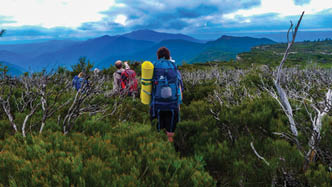
Choose your suite at 100 Man Cave
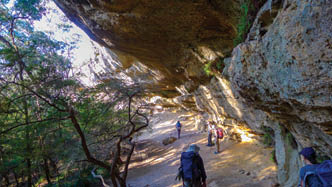
30 | BWA June 2019
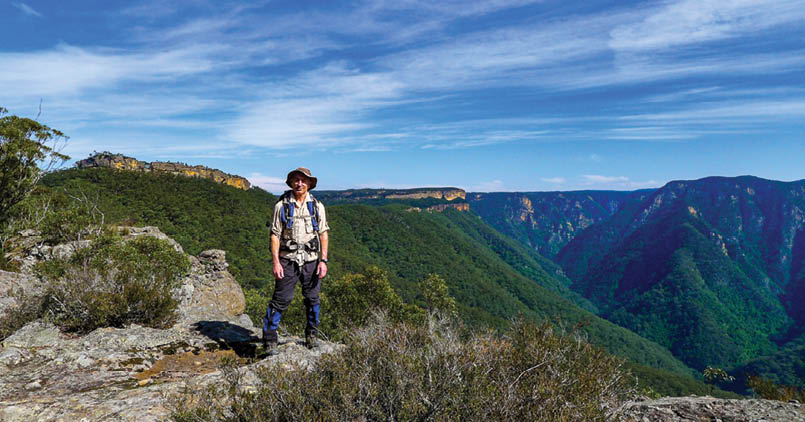


It was a meeting place for families from Picton, Burragarong, Camden and Oberon. This area was used by stockmen from sometime after 1862 until 1942.
The "wood wide web"In her book, Simpson talks about the interconnectedness of nature, referring to Peter Wohlleben’s explanation of how trees share resources (including carbon, nitrogen, nutrients and water) through root systems and fungal networks, a "wood wide web". It’s a theme also addressed in the 2018 Booker Prize shortlisted The Overstory, by Richard Powers.
Trees are also able to send off warning signals when attacked by pests to other trees, which can proactively produce enzymes to help resist the attack. Collectively, Simpson says, this collaboration and interdependency helps make the collective more resilient to disease, pests and climate change. (I wonder if humans travelling through these webs are warily watched, or watched out for, considering our history of wilderness destruction.)
Gordon Smith Pass connects the plateaus of Kanangra Tops to Kilpatricks Causeway. It’s slow going walking along the plateaus. Not because of the physicality required, but because of the breadth of stunning perspectives that exist from their edge across and deep into the gorge. Glimpses of the Thurat Spires and Danae Brook are among those features crowding the facing
hillside. Paths through the thick heath are often narrow and maze-like, but if you keep the cliff relatively close on one side (not too close – careful of the drop!) navigation is generally straightforward.
After leaving the heath, vegetation along the walk is a mix of wet and dry sclerophyll forest, the composition influenced by altitude and exposure. Beneath the gangling eucalypt coverage there are species such as Blue Mountains mallee, silver top ash, acacia, shrubby platysace, prickly broom heath, rough wax plant, daphne heath, trigger plants and spikey mat-rush. Ferns are common in shaded, wetter regions. Stormbreaker is crowned by a striking grove of grass trees.
Ranging on the ridgeThe plateaus are linked via Kilpatrick Causeway to Crafts Walls (about 4 kilometres from the trackhead), a sort of mini-Kanangra Walls, but rising up from the track rather than descending from it. While the northern side of these walls is the most clearly worn route, the southern side is an interesting option, too, but one where battle needs to be occasionally undertaken with undergrowth. The latter route features a series of overhangs, typical of the area, many of which have clearly provided shelter to visitors in the past. Large swathes of the walls are coloured a brilliant orange. About halfway around there is a steep scramble up to the top of the walls (near impossible for walkers to access from the northern side) where, from an eyrie, galvanising views exist.
Kanangra Gorge - a World Heritage Area star attraction
BWA June 2019 | 31
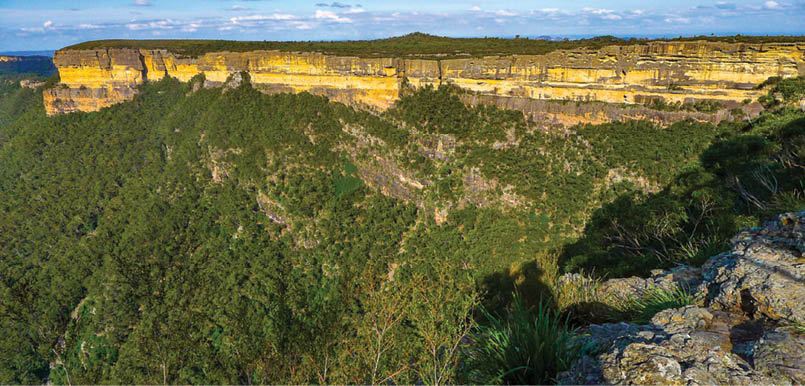
Both near and far, the walk is characterised by stern, implacable walls of rock. Throughout, trees struggle for footholds, tenaciously clinging to the precipitous slopes that dive calamitously down to Kanangra Creek’s abyss, somehow scrounging out sustenance and security, much to the rock’s haughty disdain.
From Crafts Walls the walk follows the ridge along Gangerang Range, up Mount Berry. A tricky navigation point appears about 6.5 kilometres after walk kick-off, where you scramble left up through the first real obvious – wide and leaf/branch-littered – ramp between gigantic shoulders of rock. Then on to Mount High and Mighty to Stormbreaker, before you are ripped, racked, roared and rumbled on the final climb to the walk’s highest point in Mount Cloudmaker (1164 metres), comprised of eroded remnants of Ordovician period quartzite, which is about 10.5 kilometres from the trackhead.
Then it’s not far down the hillside – south-ish, curving to the left – to 100 Man Cave, through a romantic glade of she-oaks where, for the first time, the track becomes nebulous at best.
In this quiet maze, sounds are cushioned by the dry needles you just about float over, a serene treat after the rocky terrain – sometimes smooth, sometimes punishingly jagged – traversed thus far. Here, there is an ebb and flow of murmurs, cut through by barely audible bird calls, released as if to
prove they are alive and have not succumbed to the repression pervading these woods. Staying to the higher ground, an east-ish wander eventually reveals a couple of pads.
The trick here is to keep left, or else you end up on top of the Ti Willa Plateau protrusion that features 100 Man Cave, more an overhang than a cave, but either way its capacious enough to tabernacle a large number of people within a few different chambers. Down the hill is a creek (a flowing supply is not guaranteed), the only water source encountered on the walk, other than some puddles on the tops near the walk’s beginning.
The consideration of treesDay two, on awakening, a sombre dawn light greeted us at the cave. The sun – in a stupor – was reticent in revealing itself.
The leaning trees were ambivalent, too, their congestion of dun foliage contributing to the light’s glaucousness. Or perhaps this leaning
Banksia
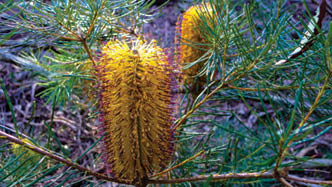
The famous Kanangra Walls
32 | BWA June 2019

The author wishes to thank Roger Browne (walk leader) and the Sydney Bush Walkers Club, under the aegis of which this walk took place.
Craig uses bushwalking to unchain the imagination and free himself from the human wrangling that accompanies corporate life in the big city. How that is consistent with his other "recreational" physical activity, that of coaching teenagers in confrontational, competitive football, remains a mystery. He’s all for stopping the production of single-use plastic bottles and is aghast at the notion of softening Tasmania's South Coast Track.
reflected a consideration of our situation; and whether to make the final commitment to reach out and embrace our warmth – invite us to become part of their web after all; or perhaps to tap into our lifeforce, expressed most acutely to the trees in our mobility that they, once rooted from their germinating seed, can only attain through the spreading of their own progeny, and the glacial pace of their roots’ exploration.
While the trip to the cave and back from the trackhead can be undertaken in a day, it would need to be quite the racing clip. Taking two days, at a moderate pace, means a relaxing evening at the cave can be held. Include a fire-light gathering of friends in the cave’s hallowed precinct. The two-day two-way exercise also allows a closer examination of the views, enriched by variations in perspectives over "that" unforgettable gorge.
Views on the leg out dissolved into haze. Coming back, the atmosphere was crystalline. Though packed with memorable vistas, this was a quiet walk for animal and bird activity. A domestic cat gone wild in the plateaus’ heath, and rare birdlife, was all that was spotted or heard. Unseen, however, but clearly active, was life rampant and pulsating beyond our visual acuity, battalions of organisms, so profligate in numbers we can’t go close to calculating their breadth.
And even if not apparent to any noteworthy degree on this autumnal walk, in Australia we often have beautiful flies as accompanying friends. A lack of flies signifies, horror, we are inside. Imprisoned?
Flies are emblematic of being out of, and beyond, doors; a radical minimisation of the anaesthetisation the suburbanisation of our lives entails.
Flies are the wild: small, imperturbable, relentless, resistant to swipes and swearing, an intrinsic link in nature’s chain: predators, parasites, prey and pollinators. They are a fundamental element in the food chain, a chain formed not to "leash" us but, conversely, to “unleash” us from the inherently confrontational battleground of the built environment and the aggression that goes into its making.
Imagining, storytelling, dreamtiming …The narrative of the walk is analogous to the telling of a story; or perhaps a poem is a better metaphor, with its lateral flights of invention and investigation, a series of encounters and insights oftentimes held together by little more than temperament. It could be a meditation, too, though heaving a 20 kilogram pack up a steep slope has never felt very Zen-like to me.
Whether articulated in words and images, or whether confined to memory, mind or soul, there is within us the atavistic facility, and proclivity, to record the exploring. If we are exploring the outdoors, isn’t it logical to explore the experience mentally to give it more value?
Being outdoors, especially in a wild area unfettered by civilisation’s conveniences, clutter and constraints, the mind’s rigidity is unlocked. The more conscious mental – or intellectual – exploration of the walk takes us into the imprecise (and all the more enjoyable for this lack of strictures) emotional and spiritual realms.
I tend to think wild walking gives free reign, and sustaining fortitude, to both of Leopardi’s stated kinds of imagination: “the strong, the promiscuous”. By delivering one of this country’s pre-eminent bushwalks, ultimately the 100 Man Cave expedition also provides inspiration for all kinds of storytelling or – through the refracted prism of other times, languages and cultures – “dreamtiming.”

BWA June 2019 | 33